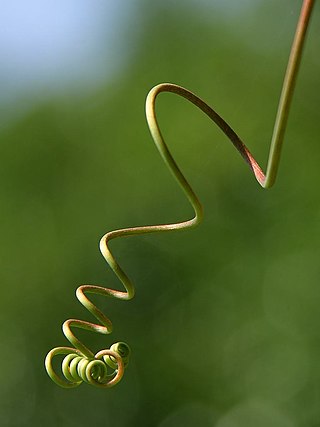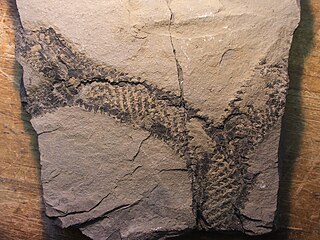
Plant cells are the cells present in green plants, photosynthetic eukaryotes of the kingdom Plantae. Their distinctive features include primary cell walls containing cellulose, hemicelluloses and pectin, the presence of plastids with the capability to perform photosynthesis and store starch, a large vacuole that regulates turgor pressure, the absence of flagella or centrioles, except in the gametes, and a unique method of cell division involving the formation of a cell plate or phragmoplast that separates the new daughter cells.

Xylem is one of the two types of transport tissue in vascular plants, the other being phloem. The basic function of the xylem is to transport water from roots to stems and leaves, but it also transports nutrients. The word xylem is derived from the Ancient Greek word ξύλον (xylon), meaning "wood"; the best-known xylem tissue is wood, though it is found throughout a plant. The term was introduced by Carl Nägeli in 1858.

Vascular plants, also called tracheophytes or collectively tracheophyta, form a large group of land plants that have lignified tissues for conducting water and minerals throughout the plant. They also have a specialized non-lignified tissue to conduct products of photosynthesis. Vascular plants include the clubmosses, horsetails, ferns, gymnosperms, and angiosperms. Scientific names for the group include Tracheophyta, Tracheobionta and Equisetopsida sensu lato. Some early land plants had less developed vascular tissue; the term eutracheophyte has been used for all other vascular plants, including all living ones.

Aquatic plants are plants that have adapted to living in aquatic environments. They are also referred to as hydrophytes or macrophytes to distinguish them from algae and other microphytes. A macrophyte is a plant that grows in or near water and is either emergent, submergent, or floating. In lakes and rivers, macrophytes provide cover for fish, substrate for aquatic invertebrates, produce oxygen, and act as food for some fish and wildlife.

The Pinaceae, or pine family, are conifer trees or shrubs, including many of the well-known conifers of commercial importance such as cedars, firs, hemlocks, piñons, larches, pines and spruces. The family is included in the order Pinales, formerly known as Coniferales. Pinaceae have distinctive cones with woody scales bearing typically two ovules, and are supported as monophyletic by both morphological trait and genetic analysis. They are the largest extant conifer family in species diversity, with between 220 and 250 species in 11 genera, and the second-largest in geographical range, found in most of the Northern Hemisphere, with the majority of the species in temperate climates, but ranging from subarctic to tropical. The family often forms the dominant component of boreal, coastal, and montane forests. One species, Pinus merkusii, grows just south of the equator in Southeast Asia. Major centres of diversity are found in the mountains of southwest China, Mexico, central Japan, and California.

The embryophytes are a clade of plants, also known as Embryophyta or land plants. They are the most familiar group of photoautotrophs that make up the vegetation on Earth's dry lands and wetlands. Embryophytes have a common ancestor with green algae, having emerged within the Phragmoplastophyta clade of freshwater charophyte green algae as a sister taxon of Charophyceae, Coleochaetophyceae and Zygnematophyceae. Embryophytes consist of the bryophytes and the polysporangiophytes. Living embryophytes include hornworts, liverworts, mosses, lycophytes, ferns, gymnosperms and angiosperms. Embryophytes have diplobiontic life cycles.

In botany, a tendril is a specialized stem, leaf or petiole with a threadlike shape used by climbing plants for support and attachment, as well as cellular invasion by parasitic plants such as Cuscuta. There are many plants that have tendrils; including sweet peas, passionflower, grapes and the Chilean glory-flower. Tendrils respond to touch and to chemical factors by curling, twining, or adhering to suitable structures or hosts. Tendrils vary greatly in size from a few centimeters up to 27 inches for Nepenthes harryana The chestnut vine can have tendrils up to 20.5 inches in length. Normally there is only one simple or branched tendril at each node, but the aardvark cucumber can have as many as eight.

Non-vascular plants are plants without a vascular system consisting of xylem and phloem. Instead, they may possess simpler tissues that have specialized functions for the internal transport of water.

The apoplast is the extracellular space outside of plant cell membranes, especially the fluid-filled cell walls of adjacent cells where water and dissolved material can flow and diffuse freely. Fluid and material flows occurring in any extracellular space are called apoplastic flow or apoplastic transport. The apoplastic pathway is one route by which water and solutes are transported and distributed to different places through tissues and organs, contrasting with the symplastic pathway.

A vessel element or vessel member is one of the cell types found in xylem, the water conducting tissue of plants. Vessel elements are found in most angiosperms but absent from most gymnosperms such as conifers. Vessel elements are the main feature distinguishing the "hardwood" of angiosperms from the "softwood" of conifers.

A hydathode is a type of pore, commonly found in angiosperms, that secretes water through pores in the epidermis or leaf margin, typically at the tip of a marginal tooth or serration. Hydathodes occur in the leaves of submerged aquatic plants such as Ranunculus fluitans as well as herbaceous plants of drier habitats such as Campanula rotundifolia. They are connected to the plant vascular system by a vascular bundle. Hydathodes are commonly seen in water lettuce, water hyacinth, rose, balsam, and many other species.
The ascent of sap in the xylem tissue of plants is the upward movement of water and minerals from the root to the aerial parts of the plant. The conducting cells in xylem are typically non-living and include, in various groups of plants, vessel members and tracheids. Both of these cell types have thick, lignified secondary cell walls and are dead at maturity. Although several mechanisms have been proposed to explain how sap moves through the xylem, the cohesion-tension mechanism has the most support. Although cohesion-tension has received criticism due to the apparent existence of large negative pressures in some living plants, experimental and observational data favor this mechanism.

Asteliaceae is a family of flowering plants, placed in the order Asparagales of the monocots.

The evolution of plants has resulted in a wide range of complexity, from the earliest algal mats of unicellular archaeplastids evolved through endosymbiosis, through multicellular marine and freshwater green algae, to spore-bearing terrestrial bryophytes, lycopods and ferns, and eventually to the complex seed-bearing gymnosperms and angiosperms of today. While many of the earliest groups continue to thrive, as exemplified by red and green algae in marine environments, more recently derived groups have displaced previously ecologically dominant ones; for example, the ascendance of flowering plants over gymnosperms in terrestrial environments.

Wood anatomy is a scientific sub-area of wood science, which examines the variations in xylem anatomical characteristics across trees, shrubs, and herbaceous species to explore inquiries related to plant function, growth, and the environment.

Lepidodendrales or arborescent lycophytes are an extinct order of primitive, vascular, heterosporous, arborescent (tree-like) plants belonging to Lycopodiopsida. Members of Lepidodendrales are the best understood of the fossil lycopsids due to the vast diversity of Lepidodendrales specimens and the diversity in which they were preserved; the extensive distribution of Lepidodendrales specimens as well as their well-preservedness lends paleobotanists exceptionally detailed knowledge of the coal-swamp giants’ reproductive biology, vegetative development, and role in their paleoecosystem. The defining characteristics of the Lepidodendrales are their secondary xylem, extensive periderm development, three-zoned cortex, rootlike appendages known as stigmarian rootlets arranged in a spiralling pattern, and megasporangium each containing a single functional megaspore that germinates inside the sporangium. Many of these different plant organs have been assigned both generic and specific names as relatively few have been found organically attached to each other. Some specimens have been discovered which indicate heights of 40 and even 50 meters and diameters of over 2 meters at the base. The massive trunks of some species branched profusely, producing large crowns of leafy twigs; though some leaves were up to 1 meter long, most were much shorter, and when leaves dropped from branches their conspicuous leaf bases remained on the surface of branches. Strobili could be found at the tips of distal branches or in an area at the top of the main trunk. The underground organs of Lepidodendrales typically consisted of dichotomizing axes bearing helically arranged, lateral appendages serving an equivalent function to roots. Sometimes called "giant club mosses", they are believed to be more closely related to extant quillworts based on xylem, although fossil specimens of extinct Selaginellales from the Late Carboniferous also had secondary xylem.
This article attempts to place key plant innovations in a geological context. It concerns itself only with novel adaptations and events that had a major ecological significance, not those that are of solely anthropological interest. The timeline displays a graphical representation of the adaptations; the text attempts to explain the nature and robustness of the evidence.

A stem is one of two main structural axes of a vascular plant, the other being the root. It supports leaves, flowers and fruits, transports water and dissolved substances between the roots and the shoots in the xylem and phloem, photosynthesis takes place here, stores nutrients, and produces new living tissue. The stem can also be called halm or haulm or culms.

Banded tubes are a type of phytoclast consisting of micrometre-scale tubes with a banded internal ornamentation, and known from terrestrial/freshwater settings from the Early Silurian onwards.

Macarthuriaceae is a family of plants in the order Caryophyllales and consists of a single genus, Macarthuria.


















